
Rabbit Anti-Phospho-HDAC3 (Ser424)antibody
HDAC3 (phospho S424); HDAC3 (phospho Ser424); p-HDAC3 (Ser424); HDAC3_HUMAN; Histone deacetylase 3; EC:3.5.1.98; HD3; Protein deacetylase HDAC3; EC:3.5.1.; Protein deacylase HDAC3; RPD3-2; SMAP45; SMAP 45; SMAP-45; RPD3; KDAC3;
View History [Clear]
Details
Product Name Phospho-HDAC3 (Ser424) Chinese Name 磷酸化组蛋白去乙酰化酶3抗体 Alias HDAC3 (phospho S424); HDAC3 (phospho Ser424); p-HDAC3 (Ser424); HDAC3_HUMAN; Histone deacetylase 3; EC:3.5.1.98; HD3; Protein deacetylase HDAC3; EC:3.5.1.; Protein deacylase HDAC3; RPD3-2; SMAP45; SMAP 45; SMAP-45; RPD3; KDAC3; Product Type Phosphorylated anti Research Area Tumour Developmental biology Signal transduction Immunogen Species Rabbit Clonality Polyclonal React Species Human, Mouse, Rat, Applications WB=1:500-2000 ELISA=1:5000-10000 IHC-P=1:100-500 IHC-F=1:100-500 Flow-Cyt=1ug/Test IF=1:100-500 (Paraffin sections need antigen repair)
not yet tested in other applications.
optimal dilutions/concentrations should be determined by the end user.Theoretical molecular weight 47kDa Cellular localization The nucleus cytoplasmic Form Liquid Concentration 1mg/ml immunogen KLH conjugated Synthesised phosphopeptide derived from human HDAC3 around the phosphorylation site of Ser424: KE(p-S)DV Lsotype IgG Purification affinity purified by Protein A Buffer Solution 0.01M TBS(pH7.4) with 1% BSA, 0.03% Proclin300 and 50% Glycerol. Storage Shipped at 4℃. Store at -20 °C for one year. Avoid repeated freeze/thaw cycles. Attention This product as supplied is intended for research use only, not for use in human, therapeutic or diagnostic applications. PubMed PubMed Product Detail Histones play a critical role in transcriptional regulation, cell cycle progression, and developmental events. Histone acetylation/deacetylation alters chromosome structure and affects transcription factor access to DNA. The protein encoded by this gene belongs to the histone deacetylase/acuc/apha family. It has histone deacetylase activity and represses transcription when tethered to a promoter. It may participate in the regulation of transcription through its binding with the zinc-finger transcription factor YY1. This protein can also down-regulate p53 function and thus modulate cell growth and apoptosis. This gene is regarded as a potential tumor suppressor gene. [provided by RefSeq, Jul 2008]
Function:
Responsible for the deacetylation of lysine residues on the N-terminal part of the core histones (H2A, H2B, H3 and H4), and some other non-histone substrates. Histone deacetylation gives a tag for epigenetic repression and plays an important role in transcriptional regulation, cell cycle progression and developmental events. Histone deacetylases act via the formation of large multiprotein complexes. Probably participates in the regulation of transcription through its binding to the zinc-finger transcription factor YY1; increases YY1 repression activity. Required to repress transcription of the POU1F1 transcription factor. Acts as a molecular chaperone for shuttling phosphorylated NR2C1 to PML bodies for sumoylation.
Subunit:
Interacts with HDAC7 and HDAC9. Forms a heterologous complex at least with YY1. Interacts with DAXX, HDAC10 and DACH1. Found in a complex with NCOR1 and NCOR2. Component of the N-Cor repressor complex, at least composed of NCOR1, NCOR2, HDAC3, TBL1X, TBL1R, CORO2A and GPS2. Interacts with BCOR, MJD2A/JHDM3A, NRIP1, PRDM6 and SRY. Interacts with BTBD14B. Interacts with GLIS2. Interacts (via the DNA-binding domain) with NR2C1; the interaction recruits phosphorylated NR2C1 to PML bodies for sumoylation. Component of the Notch corepressor complex. Interacts with CBFA2T3 and NKAP. Interacts with APEX1; the interaction is not dependent on the acetylated status of APEX1. Interacts with and deacetylates MAPK14. Interacts with ZMYND15.
Subcellular Location:
Nucleus.
Tissue Specificity:
Widely expressed.
Post-translational modifications:
Sumoylated in vitro.
Similarity:
Belongs to the histone deacetylase family. HD type 1 subfamily.
SWISS:
O15379
Gene ID:
8841
Database links:Entrez Gene: 8841 Human
Entrez Gene: 15183 Mouse
Omim: 605166 Human
SwissProt: O15379 Human
SwissProt: O88895 Mouse
Unigene: 519632 Human
Unigene: 20521 Mouse
Unigene: 17284 Rat
Product Picture
Lane 1: Mouse NIH/3T3 cell lysates
Lane 2: Mouse Testis tissue lysates
Lane 3: Mouse Cerebrum tissue lysates
Lane 4: Rat Cerebrum tissue lysates
Primary: Anti-Phospho-HDAC3 (Ser424) (SL3174R) at 1/1000 dilution
Secondary: IRDye800CW Goat Anti-Rabbit IgG at 1/20000 dilution
Predicted band size: 47 kDa
Observed band size: 50 kDa
Sample:
MCF-7(Human) Cell Lysate at 30 ug
NIH/3T3(Mouse) Cell Lysate at 30 ug
Hela(Human) Cell Lysate at 30 ug
Primary: Anti- Phospho-HDAC3 (Ser424) (SL3174R) at 1/1000 dilution
Secondary: IRDye800CW Goat Anti-Rabbit IgG at 1/20000 dilution
Predicted band size: 50 kD
Observed band size: 50 kD
Tissue/cell: Rat rectum tissue; 4% Paraformaldehyde-fixed and paraffin-embedded;
Antigen retrieval: citrate buffer ( 0.01M, pH 6.0 ), Boiling bathing for 15min; Block endogenous peroxidase by 3% Hydrogen peroxide for 30min; Blocking buffer (normal goat serum,C-0005) at 37℃ for 20 min;
Incubation: Anti-Phospho-HDAC3, Unconjugated(SL3174R) 1:200, overnight at 4°C, followed by conjugation to the secondary antibody(SP-0023) and DAB(C-0010) staining
Blank control(black line):NIH/3T3.
Primary Antibody (green line): Rabbit Anti-Phospho-HDAC3 (Ser424) antibody (SL3174R)
Dilution:1ug/Test;
Secondary Antibody(white blue line): Goat anti-rabbit IgG-AF488
Dilution: 0.5ug/Test.
Isotype control(orange line): Normal Rabbit IgG
Protocol
The cells were fixed with 4% PFA (10min at room temperature)and then permeabilized with 90% ice-cold methanol for 20 min at -20℃, The cells were then incubated in 5%BSA to block non-specific protein-protein interactions for 30 min at room temperature .Cells stained with Primary Antibody for 30 min at room temperature. The secondary antibody used for 40 min at room temperature. Acquisition of 20,000 events was performed.Blank control(black line):Molt4.
Primary Antibody (green line): Rabbit Anti-Phospho-HDAC3 (Ser424) antibody (SL3174R)
Dilution:1ug/Test;
Secondary Antibody(white blue line): Goat anti-rabbit IgG-AF488
Dilution: 0.5ug/Test.
Isotype control(orange line): Normal Rabbit IgG
Protocol
The cells were fixed with 4% PFA (10min at room temperature)and then permeabilized with 90% ice-cold methanol for 20 min at -20℃, The cells were then incubated in 5%BSA to block non-specific protein-protein interactions for 30 min at room temperature .Cells stained with Primary Antibody for 30 min at room temperature. The secondary antibody used for 40 min at room temperature. Acquisition of 20,000 events was performed.
Bought notes(bought amounts latest0)
No one bought this product
User Comment(Total0User Comment Num)
- No comment
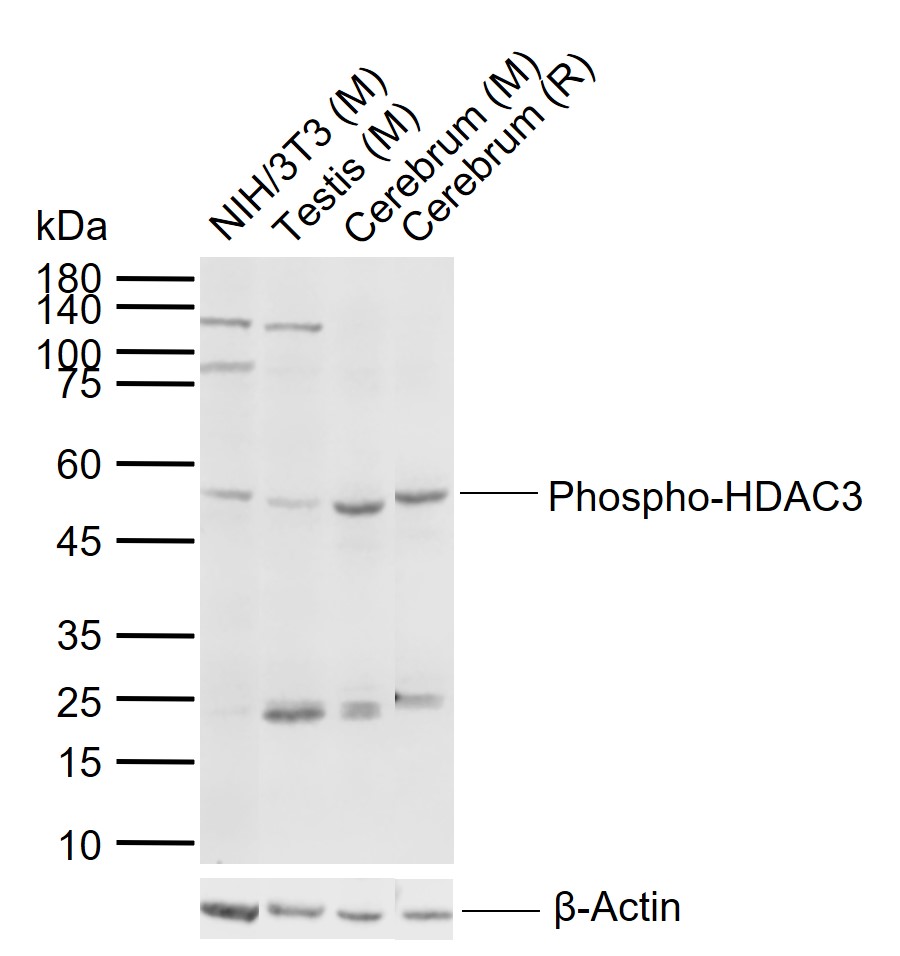
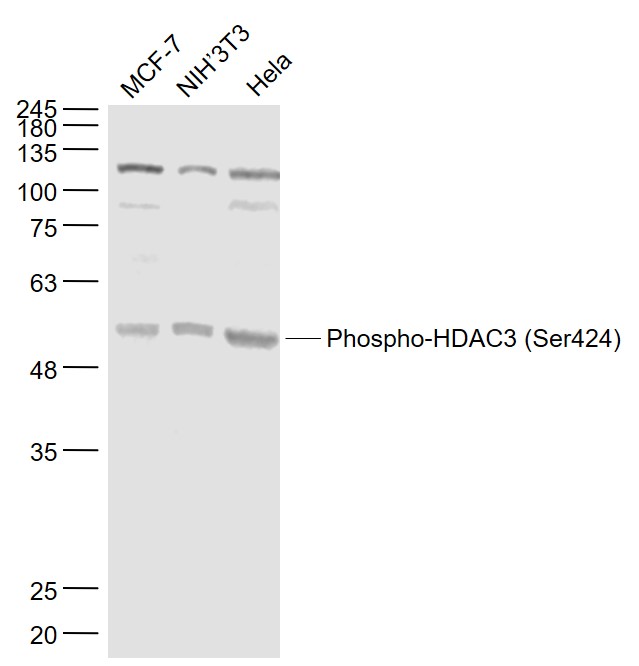
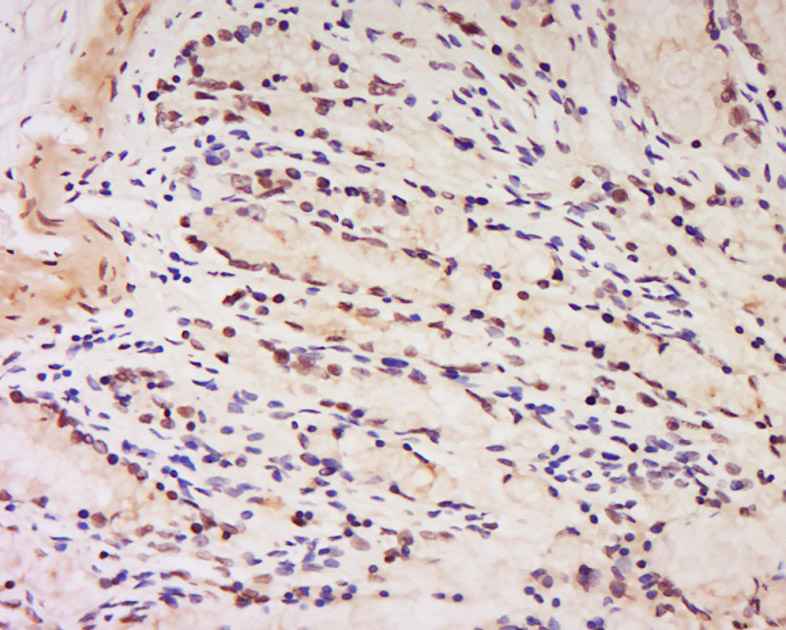
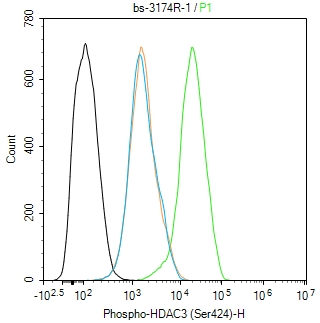
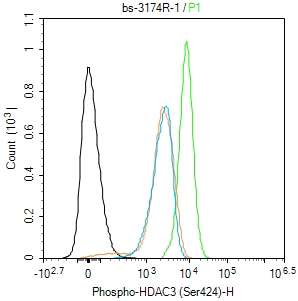


 +86 571 56623320
+86 571 56623320
 +86 18668110335
+86 18668110335

